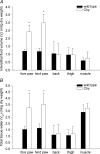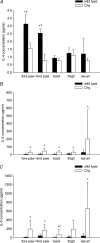Transcapillary fluid balance consequences of missing initial lymphatics studied in a mouse model of primary lymphoedema
- PMID: 16675495
- PMCID: PMC1817763
- DOI: 10.1113/jphysiol.2006.108308
Transcapillary fluid balance consequences of missing initial lymphatics studied in a mouse model of primary lymphoedema
Abstract
To investigate the phenotypic consequences of a deranged lymphangiogenesis in relation to tissue fluid accumulation and the possible role of inflammation in the pathogenesis of lymphoedema, we measured determinants of transcapillary fluid filtration and inflammatory mediators in the interstitial fluid in genetically engineered Chy mice, a model for primary congenital lymphoedema (Milroy's disease). Although initial lymphatics were not present in dermis in any of the areas studied (fore paw, hind paw, thigh and back skin) interstitial fluid pressure (P(if)), measured with micropipettes, and tissue fluid volumes were significantly increased only in the areas with visible swelling - the fore and hind paw, whereas interstitial colloid osmotic pressure (COP(if)) was increased in all the skin areas examined. A volume load of 15% of body weight resulted in a more pronounced increase in P(if) as well as a four-fold increase in interstitial fluid volume in Chy relative to wild-type (wt) mice, showing the quantitative importance of lymphatics for fluid homeostasis during acute perturbations. A similar level of proinflammatory markers in interstitial fluid in early established lymphoedema (3-4 months) in Chy and wt suggests that inflammation does not have a major pathogenetic role for the development of lymphoedema, whereas a reduced level of the immunomodulatory cytokine interleukin (IL)-4 may result in a reduced immunological defence ability and thus lead to the increase in inflammatory cytokines IL-2 and IL-6 observed at a later stage (11-13 months). Our data suggest that primary lymphoedema results in a high interstitial fluid protein concentration that does not induce an interstitial inflammatory reaction per se, and furthermore shows the paramount importance of the initial lymphatics in tissue fluid homeostasis, especially during perturbations of transcapillary fluid balance.
Figures








Comment in
-
Of mice and men; the translational physiology of a genetic form of lymphoedema.J Physiol. 2006 Jul 15;574(Pt 2):331. doi: 10.1113/jphysiol.2006.114124. Epub 2006 May 25. J Physiol. 2006. PMID: 16728443 Free PMC article. No abstract available.
Similar articles
-
Increased interstitial protein because of impaired lymph drainage does not induce fibrosis and inflammation in lymphedema.Arterioscler Thromb Vasc Biol. 2013 Feb;33(2):266-74. doi: 10.1161/ATVBAHA.112.300384. Epub 2013 Jan 3. Arterioscler Thromb Vasc Biol. 2013. PMID: 23288156
-
Lymphangiogenesis Facilitates Initial Lymph Formation and Enhances the Dendritic Cell Mobilizing Chemokine CCL21 Without Affecting Migration.Arterioscler Thromb Vasc Biol. 2017 Nov;37(11):2128-2135. doi: 10.1161/ATVBAHA.117.309883. Epub 2017 Sep 21. Arterioscler Thromb Vasc Biol. 2017. PMID: 28935759
-
Importance of lymph vessels in the transcapillary fluid balance in the gingiva studied in a transgenic mouse model.Am J Physiol Heart Circ Physiol. 2010 Aug;299(2):H275-83. doi: 10.1152/ajpheart.01199.2009. Epub 2010 May 14. Am J Physiol Heart Circ Physiol. 2010. PMID: 20472760
-
[Lymphatic system: Anatomy, histology and physiology].Presse Med. 2010 Dec;39(12):1269-78. doi: 10.1016/j.lpm.2010.09.009. Epub 2010 Nov 18. Presse Med. 2010. PMID: 21087839 Review. French.
-
Lymphatic endothelial cells, lymphedematous lymphangiogenesis, and molecular control of edema formation.Lymphat Res Biol. 2008;6(3-4):123-37. doi: 10.1089/lrb.2008.1005. Lymphat Res Biol. 2008. PMID: 19093784 Review.
Cited by
-
Dermal collagen and lipid deposition correlate with tissue swelling and hydraulic conductivity in murine primary lymphedema.Am J Pathol. 2010 Mar;176(3):1122-9. doi: 10.2353/ajpath.2010.090733. Epub 2010 Jan 28. Am J Pathol. 2010. PMID: 20110415 Free PMC article.
-
Lymphatic vessels and tertiary lymphoid organs.J Clin Invest. 2014 Mar;124(3):953-9. doi: 10.1172/JCI71611. Epub 2014 Mar 3. J Clin Invest. 2014. PMID: 24590281 Free PMC article. Review.
-
Quantitative imaging of lymphatic function with liposomal indocyanine green.Cancer Res. 2010 Sep 15;70(18):7053-62. doi: 10.1158/0008-5472.CAN-10-0271. Epub 2010 Sep 7. Cancer Res. 2010. PMID: 20823159 Free PMC article.
-
Of mice and men; the translational physiology of a genetic form of lymphoedema.J Physiol. 2006 Jul 15;574(Pt 2):331. doi: 10.1113/jphysiol.2006.114124. Epub 2006 May 25. J Physiol. 2006. PMID: 16728443 Free PMC article. No abstract available.
-
Inflammation-induced lymphangiogenesis and lymphatic dysfunction.Angiogenesis. 2014 Apr;17(2):325-34. doi: 10.1007/s10456-014-9416-7. Epub 2014 Jan 22. Angiogenesis. 2014. PMID: 24449090 Free PMC article. Review.
References
-
- Alitalo K, Tammela T, Petrova TV. Lymphangiogenesis in development and human disease. Nature. 2005;438:946–953. - PubMed
-
- Aukland K, Reed RK. Interstitial-lymphatic mechanisms in the control of extracellular fluid volume. Physiol Rev. 1993;73:1–78. - PubMed
-
- Bates DO, Levick JR, Mortimer PS. Subcutaneous interstitial fluid pressure and arm volume in lymphoedema. Int J Microcirc Clin Exp. 1992;11:359–373. - PubMed
Publication types
MeSH terms
Substances
Grants and funding
LinkOut - more resources
Full Text Sources
Medical
Molecular Biology Databases

